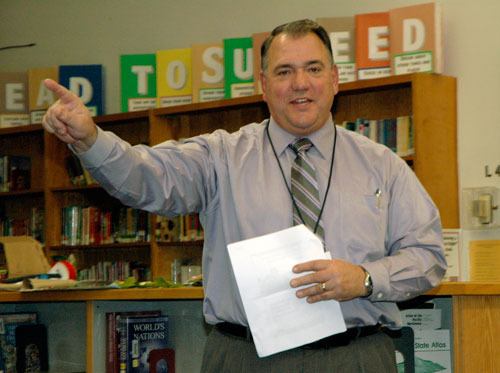MARYSVILLE — The Marysville School District has submitted two levies for the Feb. 11 election ballot, and representatives of the school district met with parents and other members of the public in the Totem Middle School library on Dec. 4 to explain the distinctions between the two levies, including the respective needs that each one seeks to serve.
Marysville School District Superintendent Dr. Becky Berg was joined by Jim Baker, executive director of finance for the school district, in explaining that the $106.4 million educational programs maintenance and operations levy is a replacement levy for an existing levy that’s otherwise set to expire at the end of 2014, while the $12 million technology levy is a new levy. Both levies are four-year levies, which would collect tax dollars from 2015-18, which means that, even if they’re approved by voters, neither levy would start collecting tax dollars until the end of next year.
“The educational programs levy is absolutely critical to the school district, because it’s not just about maintenance and operations,” Berg said. “It touches upon every area in which we work with kids. It pays for 20 percent of the daily school operating budget.”
“We’re grateful to see the tough times mostly behind us, after five straight years of budget and enrollment reductions,” Baker said. “For the first time in five years, we’ve seen upticks in student enrollment and new funds from the state, which is the good news, but we’re still at 2008-09 levels of funding support. We’ve lost a lot of ground in the intervening years, and we have a long way to go before we reach the level of our expectations.”
The replacement levy’s average annual rate would amount to an additional 30 cents per $1,000 of assessed home value, which would add up to a new cost of $60 per year on a house valued at $200,000. In return, Berg pledged that the levy would not only cover priorities such as supporting teachers and smaller classroom sizes, as well as furnishing textbooks, curriculum materials and classroom supplies, but would also help foster fine arts and other activities, including eliminating athletic participation fees through 2018.
“We’re taking a fresh look at all the fees,” Baker said.
Moving onto the new technology levy, Berg pointed out that the last technology levy approved by voters ran out in 2005.
“Anybody who’s been in our buildings knows that, unless you’re in exactly the right spots, our Internet access is unpredictable, because our equipment is aging,” Berg said. “The new technology levy basically boils down to wireless devices and access. Our students have better access at McDonald’s than they do in their classrooms.”
Berg acknowledged the rapid pace of changing technology, but speculated that the new technology levy could supply such wireless devices at a ratio of one device for every two students, which could possibly even improve to a 1:1 ratio for high school students, although she hastened to add that this was a goal rather than any kind of guarantee.
“We can’t just be giving them iPads to use as digital textbooks,” Berg said. “They should be using these devices to learn how to code and create things online. We have something like 25,000 unfilled STEM jobs in this region.”
The new technology levy would also install security cameras at the front entrance of every school, and extend wireless access to anyone in and around the schools after hours, albeit with filters to ensure that such access is being used appropriately.
“We would welcome groups who meet in our school buildings after hours to use our wireless access,” Baker said.
Berg explained that the first schools to receive the benefits of the new technology levy would likely be those that have already established themselves as early adopters of such technology, although she and Baker agreed that the details are still being worked out between now and the start of 2015.
In the wake of Berg’s admission that the Cascade and Liberty elementary schools, as well as Marysville Middle School and Marysville-Pilchuck High School, would all be priorities for bond measures, some attendees expressed concerns about installing new technology in buildings that might be demolished before too long. However, Baker assured them that any such technology would either be easily moved to new facilities or in line for upgrades by the time any new facilities are built.
“Our kids need to be leaders in this field,” Marysville School District Board President Chris Nation said. “The Board has taken this on as a priority because this kind of STEM education is not an option anymore for creating productive citizens. There are going to be haves and have-nots, and we don’t want to be on the wrong side of that.”
The average annual rate for the new technology levy would be 50 cents per $1,000 of assessed home value, or an annual new cost of $100 on a house valued at $200,000.
“That’s less than the insurance on your cell phone,” Baker said.



